Creating a Trust-Based Culture: Navigating Layoffs, Productivity Anxiety and Work-Life Balance
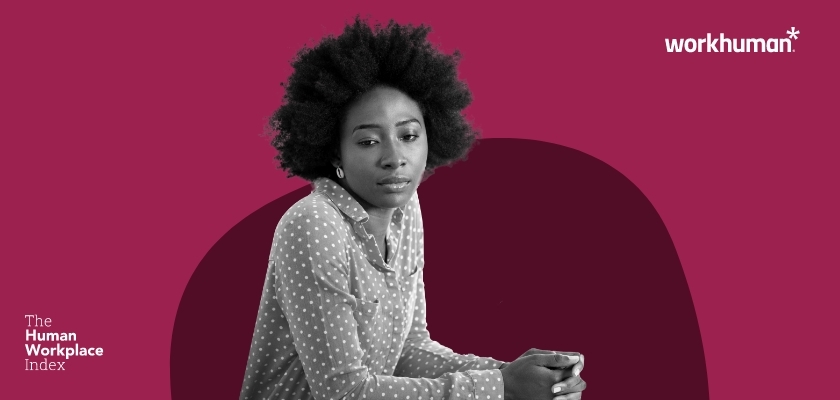
In recent years, the dynamics between employees and their employers have come under intense scrutiny. As organizations navigate rapid changes and uncertain times, the degree of trust employees place in their employers is evolving and it’s poised to create ripple effects that touch every aspect of an employee’s work life, including their wellbeing and productivity.
As Mental Health Awareness month in the US ends, it's a reminder that making time to reflect on the importance of wellbeing is an ongoing priority. When employees experience adverse impacts to wellbeing, everyone is worse-off. That’s especially true from an organizational perspective as the cost of voluntary turnover due to burnout alone is 15 - 20% of payroll, according to Workhuman and GallupOpens in a new tab.
The latest Global Human Workplace Index Survey delves into the intricacies of what the employee-employer relationship looks like for different employees and examines how trust and organizational changes impact employee wellbeing.
Let’s take a closer look.
How Trust, Work-Life Balance, and Benefits Affect Wellbeing
The survey revealed that the primary driver for cultivating employee-employer trust was established work-life balance. This was followed by open feedback loops and a culture of recognition and gratitude. About 75% of employees emphasized that work-life balance is the cornerstone of workplace wellbeing. Despite this, a significant portion of the workforce—one in every four employees surveyed—reported a lack of wellbeing perks or benefits beyond basic health insurance.
This disparity is even more pronounced among women, with about one-third not receiving any additional wellbeing perks, a disparity that is perhaps due to differing needs in health benefits. The gap between men and women was also evident when it came to trust.
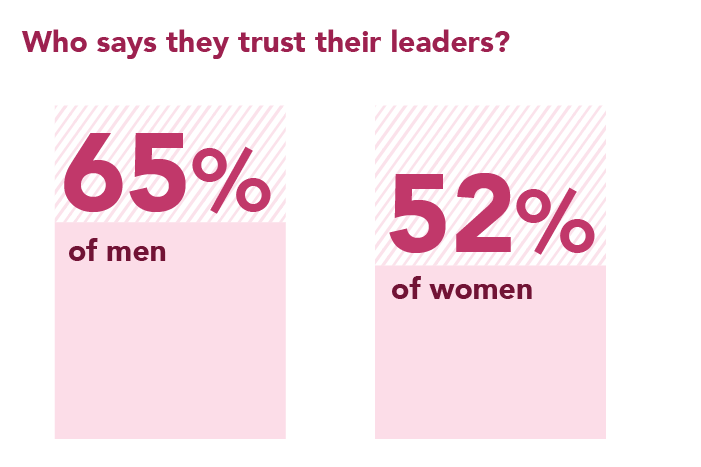
While 65% of men expressed trust in their organization's leadership, only 52% of women felt the same. These discrepancies underscore the need for organizations to take on an inclusive lens when evaluating their health benefits, implementing wellbeing practices, and ensuring that they meet the diverse needs of their workforce. Without this step, organizations risk creating an exclusionary environment where not everyone feels that they belong which spirals into a less engaged and psychologically safe workforce.
Navigating the Fallout of Layoffs
The specter of layoffs continues to loom over the workforce, contributing to widespread anxiety among employees. Among the 3,000 survey respondents, over one-third had personally experienced a layoff or worked in an organization that had conducted layoffs. The experience has left a lasting impact, with 37% of these employees feeling more anxious about future layoffs. Furthermore, 19% of employees reported losing confidence in their company’s promises and culture efforts, while 18% began looking for new job opportunities.
Younger generations, particularly Gen Z, exhibit even lower levels of trust in organizational leadership. Only 52% of Gen Z respondents reported trust in their leaders, compared to the overall average of 59%. On average, Gen Z respondents were twice as likely to be laid off compared to other generations, with 11% of them reporting being laid off versus Millennials (6%), Gen X (5%) and Boomers (5%). Gen Z, along with Millennials, were also more likely to report their organization was affected by layoffs, even if they personally were not.
The increased susceptibility to layoffs among younger employees contributes to heightened feelings of burnout and overwhelm, posing a significant challenge for employee retention and engagement with the largest contingent of workers in the workforce today.
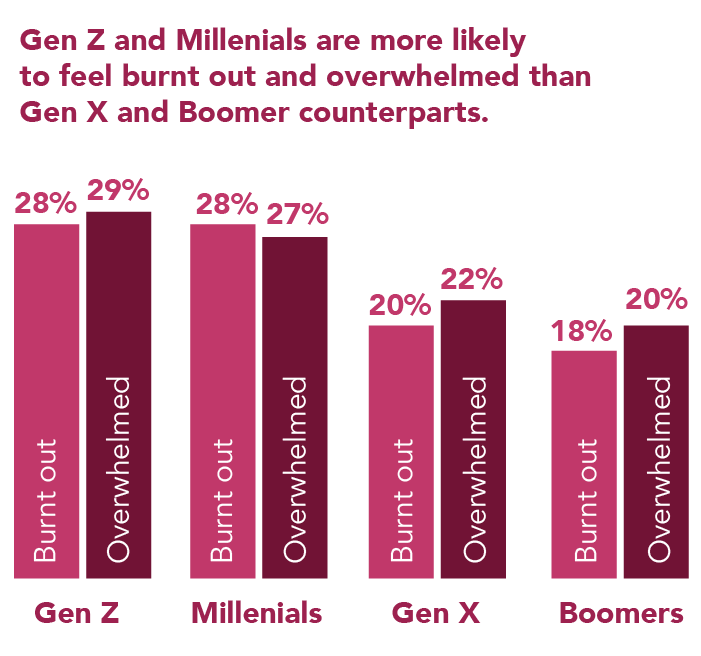
Layoffs not only deal a blow to morale and company culture but also take a toll on the wellbeing of employees who remain. Only 14% of respondents anticipated layoffs at their organization, but this figure rises to 27% among those who had previously experienced layoffs. With exposure to layoffs personally, anecdotally, and through flurries of headlines, the percentage of workers feeling the ripple effects of layoffs will likely grow.
The implications of continued uncertainty and uneasiness on overall wellbeing and productivity are profound, highlighting the need for leaders to understand how their employees are feeling and be vigilant in supporting employees both directly and indirectly affected by layoffs.
Wellbeing and Its Impact on Productivity
The relationship between employee wellbeing and productivity is complex and multifaceted. Productivity anxiety, the feeling that there is always more you should be doing, is a pervasive issue that employees face.
Nearly 83% of respondents globally reported suffering from productivity anxiety with 29% reporting feeling productivity anxiety multiple times a week.
Like with trust between employers and employees, women disproportionately report a negative outcome. One-third of women surveyed responded that they experience productivity anxiety multiple times a week compared to a quarter of men. Workhuman’s research with The She-Suite found similar sentiments with more than half of respondents reporting they were often mentally exhausted at the end of the day.
Remote workers reported experiencing productivity anxiety more frequently compared to their hybrid and in-office counterparts, with 34% of fully-remote employees saying they experienced productivity anxiety multiple times a week or every day (compared to 28% for hybrid employees and 29% in-office). Hybrid employees were almost evenly split on their productivity preferences, with 52% feeling more productive at home and 48% in the office.
The prevalence of productivity anxiety across different ways of working is a clear signal that people leaders need to consider what “productivity” looks like, and level-set with their teams. For hybrid employees, for example, productivity on an in-office day may look more like collaboration meetings and impromptu brainstorms. Meanwhile, remote days are an opportunity for asynchronous tasks. Aligning on what productivity looks like can help quell anxiety while also engaging employees in the ownership of their work, ensuring that employees in less “visible” working arrangements aren’t left feeling disengaged or unclear on expectations.
Regional and demographic differences in where employees feel most productive also emerged in the data. In Ireland, for example, most hybrid workers reported higher productivity in the office. Similarly, Gen Z hybrid workers felt more productive in the office (52%), likely due to their early-career status and the collaborative opportunities it presents.
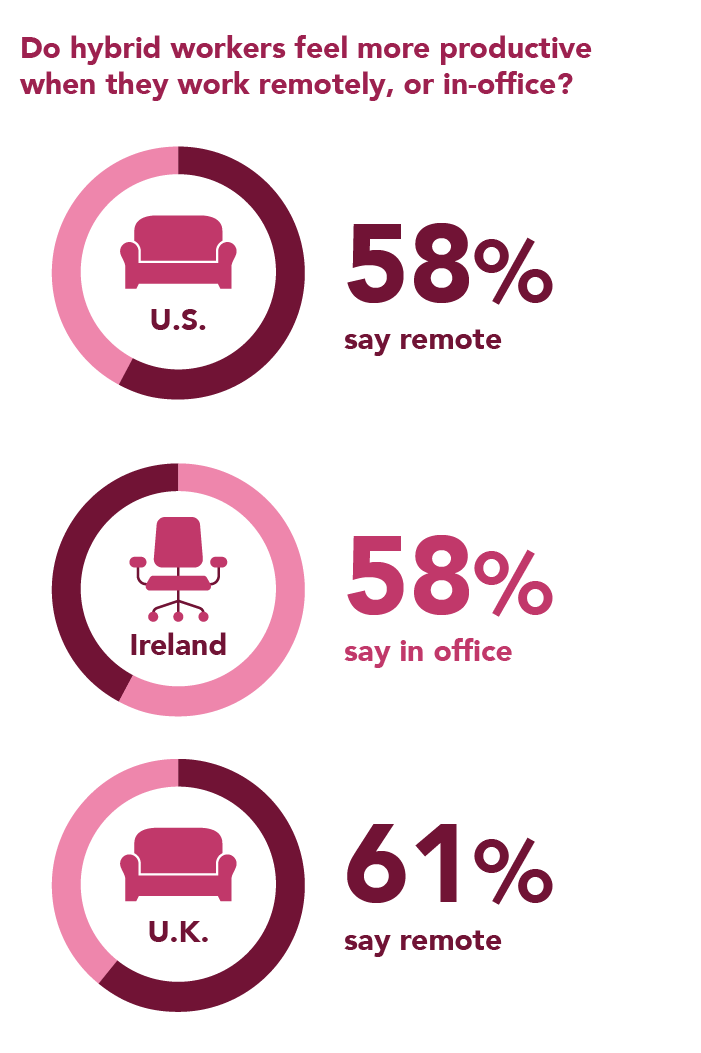
Recognition and feedback play crucial roles in mitigating productivity anxiety. Employees globally indicated that being recognized or awarded for their work, receiving more frequent feedback, and having a clear understanding of their impact on business goals are key to reducing anxiety. These elements are also essential for creating a positive work environment where employees feel valued and motivated.
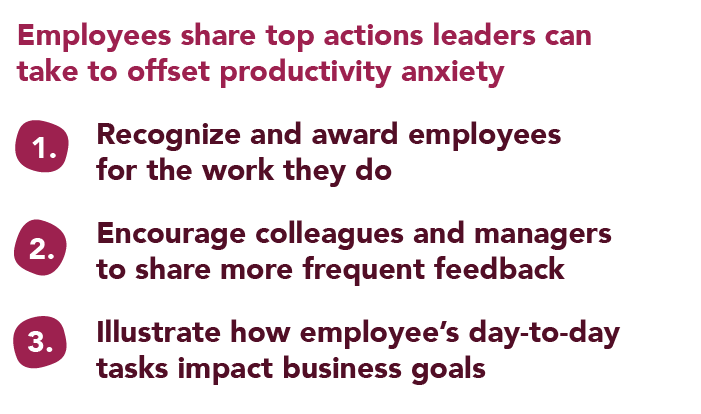
Alleviating anxiety around productivity should be a primary goal for organizations as the survey revealed that productivity is a significant determinant of employees' daily experiences. Most respondents associated a "bad day" at work with making mistakes, while a "good day" was defined by completing projects on time (55%) and receiving recognition (51%).
Ensuring that productivity does not come at the expense of employee wellbeing is vital for sustaining performance and preventing burnout. While 54% of employees reported feeling productive at work, the challenge lies in maintaining this productivity without compromising their sense of wellbeing. Organizations must strive to create a supportive work environment that prioritizes both performance and the holistic health of their employees.
Conclusion
This quarter’s Global Human Workplace Index Survey unearths some of the most crucial dynamics of the employee experience: trust, wellbeing, and anxiety. These dynamics influence the employee-employer relationship, the likelihood of burnout and turnover, and the quality of the work employees produce.
By addressing these areas and understanding what can be done to improve them, organizations can build a more resilient and engaged workforce, capable of navigating the challenges of the modern workplace with confidence and trust.